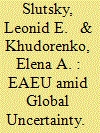| Srl | Item |
| 1 |
ID:
189829


|
|
|
|
|
| Summary/Abstract |
The article analyzes the development of the Eurasian Economic Union
(EAEU) before, during and after the COVID-19 pandemic through the
lens of the so-called integration dilemma, when one state perceives its
neighbors’ integration into an economic alliance as a threat to its own
security or prosperity. The authors consider the processes of interstate and
supranational adaptation, as well as the adaptation of the basic model of
integration to the existing practices of interaction as part of the project to
ensure four freedoms. The institutional inertia characteristic of the EAEU
and the manifest desire primarily to prevent development risks are caused by the “hybrid nature” of the integration association, in which interstate ties
and the interests of states often outweigh supranational ones. At the same
time, integration cooperation made it possible for the member states to
somewhat harmonize and coordinate their joint response to the pandemic.
Sweeping anti-Russian sanctions have created new, unprecedented risks
for integration cooperation, but at the same time have opened up certain
opportunities to overcome their consequences.
|
|
|
|
|
|
|
|
|
|
|
|
|
|
|
|
| 2 |
ID:
154465


|
|
|
|
|
| Summary/Abstract |
Events in Ukraine have rekindled discussions about NATO’s post-Cold War purpose and the way it relates to the EU. Through EU sanctions and a traditional military response from NATO, the West has manoeuvred itself into a paradoxical situation where every step it takes to reassure its Eastern allies increases rather than diffuses tensions with Russia. On the one hand, it seems that decades of carefully crafted strategic narratives of de-escalation are now in limbo. On the other, it might have indeed been the sustained attempt to create a liberal post-Cold War order that produced an “integration dilemma”, and ultimately drove Russia to the defensive realist logic of a Waltzian “security dilemma”. We argue that NATO’s reaction might have been based on a stylised threat and historical resentments rather than on a carefully calculated risk. Looking beyond the EU and NATO’s recent strategic choices, we argue that the situation can only be resolved by re-engaging Russia in a renewed de-escalatory dialogue that involves both the EU and NATO with a greater emphasis on the nuanced, but important, distinctions between the integration and security dilemmas.
|
|
|
|
|
|
|
|
|
|
|
|
|
|
|
|